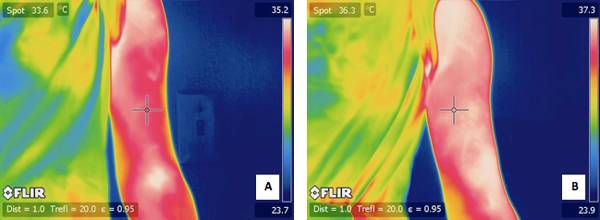Most anyone who has exercised hard or played sports is familiar with DOMS – delayed onset muscle soreness. That painful stiff soreness that strikes hard a day or two after your activity.
For researchers investigating methods for the prevention or treatment of DOMS the procedures for data collection have proven difficult. Attempts at measuring DOMS all involved subjective tools, like the visual analog scale (VAS), and more objective measures were determined impractical or dangerous.
Recently researchers at Loma Linda University decided to use thermal infra-red imaging to measure DOMS. Their work was published in written and video form through the Journal of Visualized Experiments.
In the study, researchers focused on the biceps. Only one arm of each subject was tested; the other arm was used as a control. Infra-red images of each arm were taken before exercises were prescribed and also at 24 hours and 48 hour post exercise.
Appropriate weights were selected after tests using a strain gauge to determine each subject’s strength. Subjects were then asked to perform four sets of 25 repetitions of bicep curls with the same arm, taking 90 seconds of rest between sets.
 In addition to the infra-red imaging, subjects were also asked to score their subjective soreness on a visual analog scale – ranging from “no pain” to “extremely sore.” Myoglobin was also measured through blood analysis.
In addition to the infra-red imaging, subjects were also asked to score their subjective soreness on a visual analog scale – ranging from “no pain” to “extremely sore.” Myoglobin was also measured through blood analysis.
Test Results:
- A noticeable increase in temperature of the exercised arm at the 24 hour mark.
- Pre-exercise temperature was 32.80 degrees Celcius, at the 24 hour mark arm temperature was 33.96 degrees Celcius.
- No change in temperature for the un-exercised arm at any point.
- A large increase in pain level reported on the VAS – from 3.6 pre-exercise to 36.3 at the 24 hour mark.
- High levels of pain were reported on the VAS at the 48 hour mark, as well.
- Myoglobin levels increased at the 48 hour mark by 147 nanograms per millimeter.
Based on this analysis researchers determined infra-red imaging could be an effective way to measure DOMS for future study. Researchers hypothesized the increase in temperature is likely due to friction between exercised muscle fibers, a boosted metabolism, and increased blood flow to the damaged muscle. Undamaged muscle would return to normal temperature, whereas damaged muscle would not due to the elevated circulation.
Researchers believe this information will help future researchers more effectively study prevention and treatment of DOMS as well as offer an opportunity for athletes to be more aware of damage they are incurring at practices.
Infra-red photo courtesy of Al-Nakhli, H. H., Petrofsky, J. S., Laymon, M. S., Berk, L. S. The Use of Thermal Infra-Red Imaging to Detect Delayed Onset Muscle Soreness. J. Vis. Exp. (59), e3551, DOI: 10.3791/3551 (2012).






